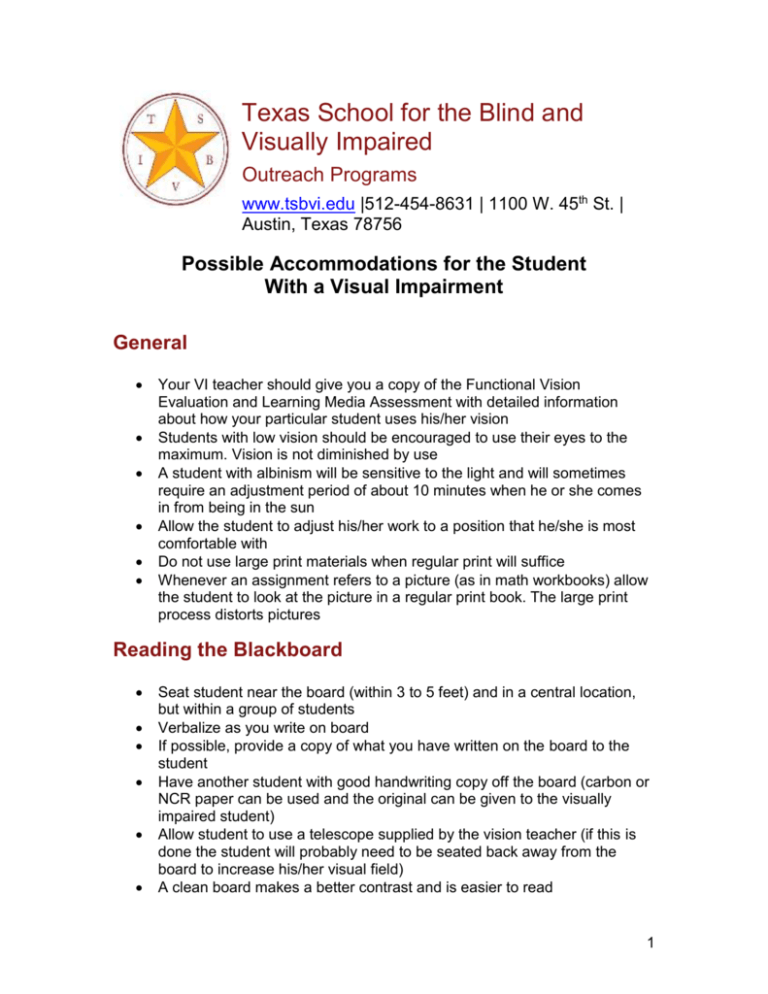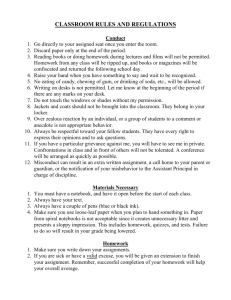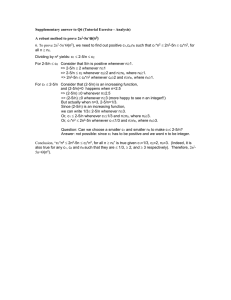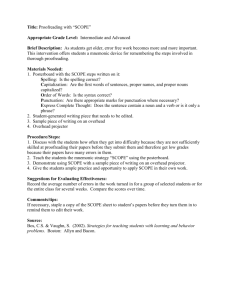classroom accommodations - Texas School for the Blind and
advertisement

Texas School for the Blind and Visually Impaired Outreach Programs www.tsbvi.edu |512-454-8631 | 1100 W. 45th St. | Austin, Texas 78756 Possible Accommodations for the Student With a Visual Impairment General Your VI teacher should give you a copy of the Functional Vision Evaluation and Learning Media Assessment with detailed information about how your particular student uses his/her vision Students with low vision should be encouraged to use their eyes to the maximum. Vision is not diminished by use A student with albinism will be sensitive to the light and will sometimes require an adjustment period of about 10 minutes when he or she comes in from being in the sun Allow the student to adjust his/her work to a position that he/she is most comfortable with Do not use large print materials when regular print will suffice Whenever an assignment refers to a picture (as in math workbooks) allow the student to look at the picture in a regular print book. The large print process distorts pictures Reading the Blackboard Seat student near the board (within 3 to 5 feet) and in a central location, but within a group of students Verbalize as you write on board If possible, provide a copy of what you have written on the board to the student Have another student with good handwriting copy off the board (carbon or NCR paper can be used and the original can be given to the visually impaired student) Allow student to use a telescope supplied by the vision teacher (if this is done the student will probably need to be seated back away from the board to increase his/her visual field) A clean board makes a better contrast and is easier to read 1 Overhead Projectors/Video Seat student close to the screen Provide student with your overhead projector sheet or master copy so he or she can read and/or copy from it Use a dark (preferably black) Vis-à-vis pen on the overhead sheet Discuss movies thoroughly afterwards to make sure the student understands major concepts presented A darkened room provides more contrast Move the projector closer to the screen to produce a smaller, more distinct image Make a good photo copy of your master Do not use red ink Record the assignment, provided that the student can function as well with a recording Please be sure that your tests are completely legible. Ask the student to read parts of the test to you privately to be sure he or she can see all parts of the test Give the student a little extra time Avoid handing the student a paper and saying, “Do the best you can”. This only cheats the student out of the continuity of your lesson and can be frustrating Illumination Light intensity can be regulated by adjusting distance from the window or light source Artificial lights should be used whenever brightness levels become low in any part of the room. Avoid glares on working surfaces (a piece of dark colored paper taped to the entire desk surface diminishes glare off the desk) Seating Avoid having students work in their own shadows or facing the light Students may need to change their seats whenever they desire more or less light Contrast White chalk offers more contrast on a clean chalkboard Dry erase boards used with dark markers offer better contrast 2 Soft lead pencils and felt-tipped pens with black ink are recommended for use on unglazed light and tinted paper Good contrast and white space between lines of print offer the best viewing comfort for lengthy reading assignments Avoid using red/orange/yellow on Smartboards Tests Tests should be dark and clear If there is a time element, please remember that a person with poor sight will frequently be a slower reader than a person with normal sight of the same intelligence. His or her eyes will tire much faster, so tests in the afternoon can be particularly difficult to read On timed drills allow at least double the time for a student with low vision. Ideally they should be untimed If the student is comfortable performing orally, tests could be given orally by another person who fills in the blanks. Please be careful here, as some people are not auditory performers, and it is a misconception that all blind and low vision students can perform better auditorily. Physical Education/Recess Check with TVI to see if there are any restrictions of activity or on visual fields Ball Sports: practice catching, kicking, and batting with students to check whether or not he/she can see the ball in time to catch, kick, or bat Use audible goals and/or balls (available from TVI) or use a radio as a goal locator (as in basketball) Mobility and Orientation Allow student to explore your room during the first week and whenever you make any major changes Show student where his or her desk is, where materials are located, papers turned in, etc. Point out the restrooms, water fountains, library, office, cafeteria, gym, and bus stops and ask that Braille labels be placed outside each entry for blind students Contact O&M specialist for detailed information 3











